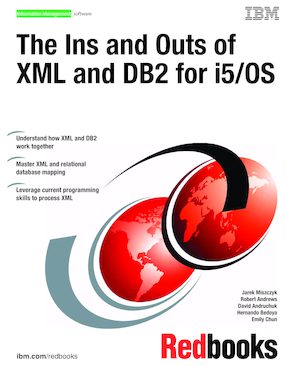The Ins and Outs of XML and DB2 for i5/OS
An IBM Redbooks publication
Note: This is publication is now archived. For reference only.

Published on 24 October 2006
Note
ISBN-10: 0738496901
ISBN-13: 9780738496900
IBM Form #: SG24-7258-00
Authors: Hernando Bedoya, Jarek Miszczyk, Robert Andrews, David Andruchuk, Hernando Bedoya and Emily Chun
XML represents a fundamental change in computing. It allows applications to move away from proprietary file and data formats to a world of open data interchange. XML has become ubiquitous not only because of its range of applications, but also because of its ease of use.
Although XML solves many problems by providing a standard format for data interchange, some challenges remain. In the real world, applications need reliable services to store, retrieve, and manipulate data. These services have traditionally been offered by DB2 for i5/OS.
In this IBM Redbooks publication, we discuss the challenges of representing XML hierarchies in the relational database model. We provide an in-depth explanation of the three most popular approaches to bridge the hierarchy, the relational model dichotomy:
We also share best practices and techniques aimed at streamlining the XML and DB2 for i5/OS integration.
Part 1. Introduction to DB2 for i5/OS and the scenario
Chapter 1. Introduction to XML integration with DB2 for i5/OS
Chapter 2. Scenario overview
Part 2. Programmatic approach
Chapter 3. Using SQL to compose XML
Chapter 4. Using XSL Transformation and SQL
Chapter 5. Using RPG for XML processing
Chapter 6. Using SAX and Java to decompose XML
Chapter 7. Advantages and disadvantages of the programmatic approach
Part 3. Middleware approach
Chapter 8. Overview of DB2 XML Extender
Chapter 9. Performance-related information regarding XML Extender
Chapter 10. Shredding methodology
Chapter 11. Composing methodology
Chapter 12. Advantages and disadvantages of the middleware approach
Part 4. Moving forward
Chapter 13. A look into the future
Appendix A. Additional material